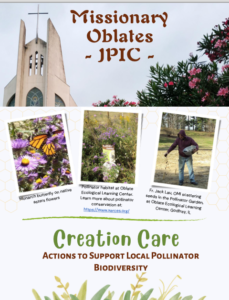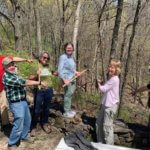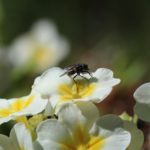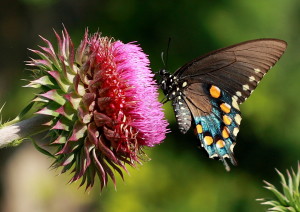News Archives » biodiversity
New Resource! Practical Ways We Can Help Pollinators August 14th, 2023
Actions to Support Local Pollinator Biodiversity
BACKGROUND
 At the UN Biodiversity Conference (COP 15) in 2022, countries agreed to return 30% of land and 30% of the oceans to nature. Seizing this momentum, in June 2023, Irish Bishops called for conservation of nearly a third of church property to become havens for pollinators and biodiversity.
At the UN Biodiversity Conference (COP 15) in 2022, countries agreed to return 30% of land and 30% of the oceans to nature. Seizing this momentum, in June 2023, Irish Bishops called for conservation of nearly a third of church property to become havens for pollinators and biodiversity.
The bishops’ initiative responds to:
- Pope Francis’ 2015 encyclical “Laudato Si, on Care for Our Common Home,”
- the impending loss of biodiversity
- and agreements made at COP15 in December 2022.
Integrity of Creation as an integral part of evangelization was re-affirmed at the Missionary Oblates of Mary Immaculate’s 37th General Chapter in September 2022.
The OMI Justice, Peace & Integrity of Creation has adapted some ideas from the Irish Bishops’ resource Faith Communities Actions to Help Pollinators and complied them as possible actions for people to take.
DOWNLOAD THE REPORT
La Vista Hosts Inter-Community Novitiate May 11th, 2023
On April 26th La Vista hosted Inter-Community Novitiate Program in St. Louis, MO. The focus was on how ecological restoration projects on the OMI Novitiate land help to preserve biodiversity. There were nine novices and three formators present.
Biomimicry & Learning from the Humble Moss May 2nd, 2023
 (Photo courtesy of Thomas Hendele, Pixabay)
(Photo courtesy of Thomas Hendele, Pixabay)
By Sr. Maxine Pohlman, SSND
Recently I participated in a Biomimicry Retreat sponsored by Sisters of Earth. Sister Gloria Rivera, our presenter, described biomimicry as learning from and emulating natural forms, processes, and ecosystems to create all kinds of sustainable design and ways of living. She taught us that biomimicry is about valuing nature for what we can learn, not what we can extract, harvest, or domesticate, and in the process, if we listen carefully, we can learn about ourselves and our connection to each other and our home on Earth.
After the first session we were encouraged to take a half hour walk outdoors, paying attention to what offered itself to us. As I hiked uphill from the river through the woods what presented itself to me over and over and over was moss. It was everywhere – all shades of green, fresh and beautiful, on the path, downed trees, even asphalt! I decided that emulating moss would be a great way to live into not only a sustainable future, but a flourishing one. I imagined what mosses might say to us, aware that they have properties we need at this challenging time on Earth:
- We are on rooftops, under your feet, on cement, in streams and on dry rocks of glades. We are comfortable in extreme conditions. Be adaptable!
- We are 350 million years old and have survived and thrived through drastic climate changes. You an do it too.
- You can find us on every continent and in every ecosystem habitable by plants that use sunlight for energy. Renewable energy can also be your way.
- We impact the temperature of soil, warming or cooling it depending on the environment. Use your creativity for the health of our planet.
- We make up a major part of the biodiversity in moist forest, wetland, mountain and tundra ecosystems. Please protect biodiversity.
- We even offer microhabitats where a variety of insects can live, lay their eggs and hunt for food. Find ways to serve animal life.
- We are in no hurry. It may take us 25 years to grow an inch. Slow down and enjoy each day.
- We are never alone; rather, it is our nature to be continuously in contact with other beings, like the ones we grow on. Value the web of life and be in touch.
Maybe you will also take a hike and see what presents itself to you for your emulation. May all of us embrace biomimicry as one hopeful way into a flourishing future!
Our Global Biodiversity Crisis – What You Can Do October 16th, 2020

Submitted by Sr. Maxine Pohlman, SSND, director, La Vista Ecological Learning Center
The loss of biodiversity on our planet is even more urgent than the climate crisis but less well-known, putting people, wildlife, and future generations at risk. Scientists report that one million species are in danger of extinction in the coming decades. Urgent action needs to be taken now to reverse the massive loss of plants, insects, and other creatures we depend on for a stable climate, sustainable food supplies and essential pollination services.
All of us can help by participating in Citizen Science Projects right in our local areas. Projects include observing wildlife, measuring night sky brightness, monitoring water quality, counting birds, monitoring bird nests, and many more. Visit the National Geographic website to get ideas. You will be working with thousands of other volunteers and scientists to gather and share important data to a global database.
Visit the National Geographic website to participate.
Photos courtesy, Unsplash.
Biodiversity Preservation Lagging October 6th, 2014
The world is severely lagging behind targets set in 2010 to preserve biodiversity, according to a new report issued by the United Nations. The report said in addition to high profile campaigns to save certain animals, preserving biodiversity also means pursuing goals like reducing nutrient pollution in rivers. Much more efficient use of land, water, energy and materials are needed to meet globally-agreed targets by 2020.
“Bold and innovative action is urgently required if governments are to meet the globally-agreed Strategic Plan for Biodiversity and its Aichi Targets by 2020,” the Montreal-based Secretariat of the Convention on Biological Diversity (CBD) said referring to the 20 biodiversity goals agreed upon in 2010 in the Japanese city of Nagoya in Aichi prefecture.
“The challenge of achievement of many of these targets stem from the reality that based on current trends, pressures on biodiversity will continue to increase at least until 2020 and that the status of biodiversity will continue to decline,” according to this latest progress report by the CBD. The report cautioned “that continuing with ‘business as usual’ in our present patterns of behaviour, consumption, production and economic incentives will not allow us to realize the vision of a world with ecosystems capable of meeting human needs into the future.”
The report, Global Diversity Outlook 4 was released today at the start of the 12th meeting of the Conference of the Parties to the Convention on Biological Diversity, known as COP-12, in Pyeongchang, Republic of Korea.












